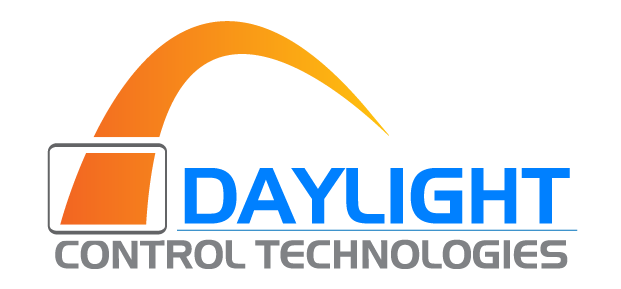Fluctuation-Mitigation Algorithm for Responsive Daylight Control

What it does
How it works
Advantages
Product applications
Detailed Description
Responsive Daylight Control
Responsive daylight control, in which shading is automatically adjusted to maintain a desired level of glare-free natural illumination, is the key to unlocking the full energy-saving, ergonomic, and health benefits of daylighting. Unfortunately, while it’s potentially the most valuable form of automated shading, it’s also virtually non-existent in today’s buildings because it’s so hard to implement with conventional technology (see our post on responsive daylight control for more on the potential benefits and challenges).
One Problem with Conventional Technology: Cloud-Induced Daylight Fluctuation
Unfortunately, conventional responsive daylight control technology just isn’t practical for mainstream use. A major reason is the fact that clouds move…and when they do, there can be rapid, high-amplitude fluctuations in the daylight level:

If a responsive daylight control system using a motorized window covering attempted to respond to such fluctuations, the resulting shading adjustments would be highly annoying, while also accelerating the wear-and-tear on the system’s electromechanical components and drastically shortening battery life in battery-powered systems.
Of course, this problem can be avoided by using a Smart Window (with no moving parts) instead of a motorized window covering. Unfortunately, Smart Windows are an order of magnitude more expensive than motorized window coverings—far too expensive for mainstream use (see our post comparing Smart Windows and motorized blinds for more info on this topic).
Due to the fluctuation issue, conventional systems using motorized window coverings that do respond to daylight levels are actually (and intentionally) not very responsive. They can open at dawn and close at dusk, or close in sustained direct sunlight, but their response times are too slow to dynamically regulate admitted daylight. This greatly limits the benefit of the daylight control capability provided by such systems.
Our Solution
Our fluctuation-mitigation technology overcomes this problem by increasing the response time for opening the shading in the presence of daylight fluctuation caused by moving clouds. It exploits the fact that cloud-induced fluctuation has a Kolmogorov spectrum in the frequency domain of interest for responsive daylight control, which can be rapidly and reliably detected with simple algorithms that require negligible processing resources.

Our approach is far more cost-effective than attempting to detect cloud-induced fluctuation using real-time weather data or sky imagery. The following figure provides an overview of the approach and shows an example of its effectiveness:

The data in the figure were collected over a partly sunny day with one of our IntelliBlind™ smart miniblind actuators. The graph on the upper right shows two sensor outputs versus time: the orange curve is the irradiance as measured by a conventional sensor, while the green curve is the output™ of our proprietary multi-spectral glare sensor after passing through the fluctuation-mitigation algorithm shown in the block diagram on the left.
The rapid high-amplitude fluctuations due to moving clouds are clearly evident in the orange irradiance curve, but are missing in the green fluctuation-mitigated glare curve—and yet the green curve drops quickly in falling daylight levels when there is no sustained fluctuation (e.g. at 11:30 and 15:45).
Incidentally, the increase in the green curve in the late morning and (especially) late afternoon is because our patented multi-spectral glare sensor is far more sensitive to direct sunlight than conventional sensors—and especially as the solar zenith angle increases. This makes our multi-spectral sensor far better than a conventional daylight sensor at sensing incipient glare.
The graph on the lower right shows the host blind’s slat-tilt setting as IntelliBlind™ performs responsive daylight control using the output of the glare sensor. If a fixed response time were used instead of our fluctuation-mitigation algorithm, then either the shading would take much longer to open (and would have remained closed at 11:30), or else there would have been a multitude of annoying shading adjustments over the course of the day.
Our fluctuation-mitigation technology provides the best of both worlds: it suppresses spurious adjustments when there is cloud-induced fluctuation—but responds quickly when there isn’t.
Implementation
Our fluctuation-mitigation algorithm can be implemented with minimal processing overhead on even the least capable 8-bit microcontrollers, so it can be added via a firmware/software update to virtually any automated shading product. On the other hand, it can also make good use of greater processing resources (e.g. as available in the cloud or a home-automation hub) to provide even more reliable fluctuation mitigation; see our patent disclosure for more information on that.
Applications
Our fluctuation-mitigation technology is highly advantageous (if not essential) for any responsive daylight control system that uses a motorized window covering (including blinds, shades, and curtains). It works equally well for internally mounted and externally mounted shading devices, and for open-loop and closed-loop control protocols.
In fact, all of the responsive daylight control technologies described on this site—including our multi-spectral glare sensor, our closed-loop daylight control algorithm for horizontal blinds, our IntelliBlind™ smart miniblind actuator, and our IntelliLux™ smart sensors—work synergistically with our fluctuation-mitigation technology.
